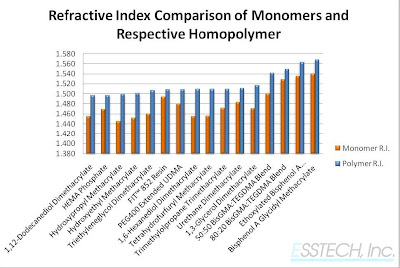Some time ago, my colleagues and I published a paper on temperature changes during curing of Filtek Silorane, Admira (ormocer) and Herculite XRV (microhybrid, control) composites. It was interesting to notice substantially higher temperature rise in Filtek Silorane compared to the other two materials. However, there was no difference in the temperature rise inside the pulp chamber, probably due to the insulating effect of the remaining dentine.
The abstract of this paper may be found on
MEDLINE and I will be happy to email the full text to anyone interested in this subject. Feel free to contact me at
vesna.miletic@gmail.com
J Esthet Restor Dent 2009;21(2):122-31.
Temperature changes in silorane-, ormocer-, and dimethacrylate-based composites and pulp chamber roof during light-curing.
Miletic V, Ivanovic V, Dzeletovic B, Lezaja M.
STATEMENT OF THE PROBLEM: Light-curing of resin-based composites (RBCs) is associated with temperature increase in the pulp chamber, which may have a detrimental effect on the vital pulp.
PURPOSE: The purpose of the study was to evaluate temperature changes of silorane-, ormocer-, and dimethacrylate-based RBCs at the bottom surface of the RBC and in the pulp chamber roof dentin (PCRD) during curing.
MATERIALS AND METHODS: In part A, temperatures were measured for Filtek LS (3M ESPE, St. Paul, MN, USA), Admira (Voco GmbH, Cuxhaven, Germany), and Herculite XRV (Kerr Corp., Orange, CA, USA) with a high-power light-emitting diode (LED) unit by placing thermocouples in contact with the bottom surface of the material in standardized acrylic molds. In part B, temperature changes in PCRD were measured in extracted molars during light-curing of adhesives and RBCs in 2-mm-deep cavities with a remaining dentin thickness (RDT) of 1 mm.
RESULTS: Filtek LS showed a different temperature curve compared with Admira and Herculite XRV. Significantly higher temperatures were recorded for Filtek LS (p < 0.001) than for Admira and Herculite XRV in acrylic molds. Temperature rises recorded in PCRD for adhesives and RBCs were between 4.1 and 6.4 degrees C. No significant differences in PCRD temperatures were found between the three groups during adhesive curing and RBC curing (p > 0.05).
CONCLUSIONS: Filtek LS showed a different heat-generation pattern from and significantly higher temperatures than Admira and Herculite XRV when the materials were tested in acrylic molds. Similar temperatures were recorded in the PCRD during curing of adhesives and RBCs.
CLINICAL SIGNIFICANCE: Although a substantial temperature rise in the bulk material occurred during light-curing of the three resin-based composites, a remaining dentin thickness of 1 mm caused a significant reduction in pulp chamber roof dentin temperatures. Temperatures measured in the pulp chamber roof dentin corresponding to the zone occupied by the postmitotic odontoblast layer were not statistically different for the three types of resin-based composites.
***********************************************************************************
 Esstech, Inc. develops and manufactures advanced materials for many biomedical fields including dental materials. In their range of products are various monomers, initiators, silanated glass etc. for resin-based composites and adhesive systems. The latest research by or using Esstech's products includes studies on physical properties of new low shrink resin , optimizing the degee of conversion and certain physical properties of various BisGMA/BisEMA/TEGDMA formulations , optimizing silanated glass , developing a high molecular mass monomer to substitute HEMA etc.
Esstech, Inc. develops and manufactures advanced materials for many biomedical fields including dental materials. In their range of products are various monomers, initiators, silanated glass etc. for resin-based composites and adhesive systems. The latest research by or using Esstech's products includes studies on physical properties of new low shrink resin , optimizing the degee of conversion and certain physical properties of various BisGMA/BisEMA/TEGDMA formulations , optimizing silanated glass , developing a high molecular mass monomer to substitute HEMA etc.









